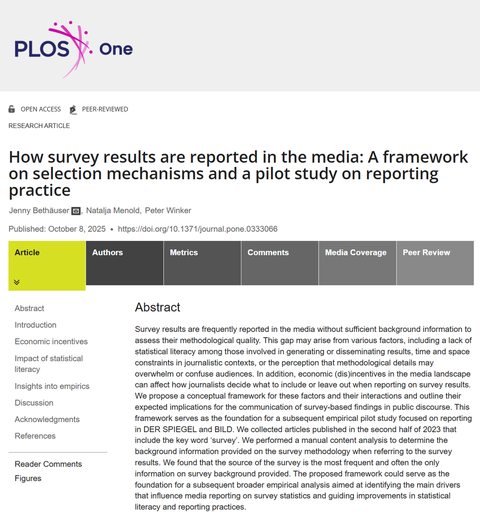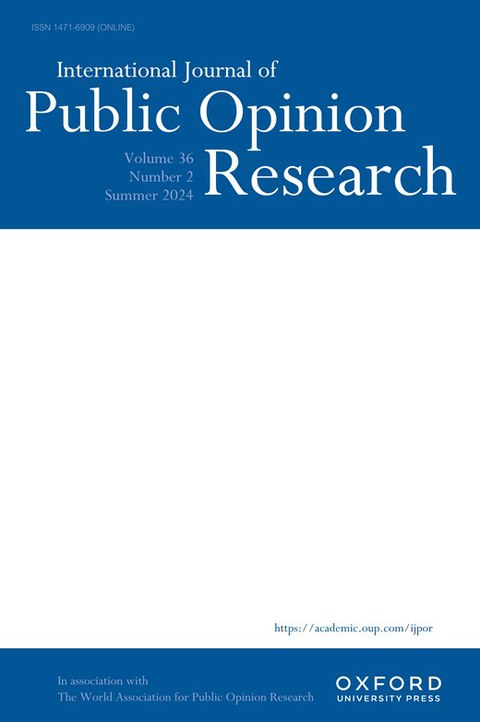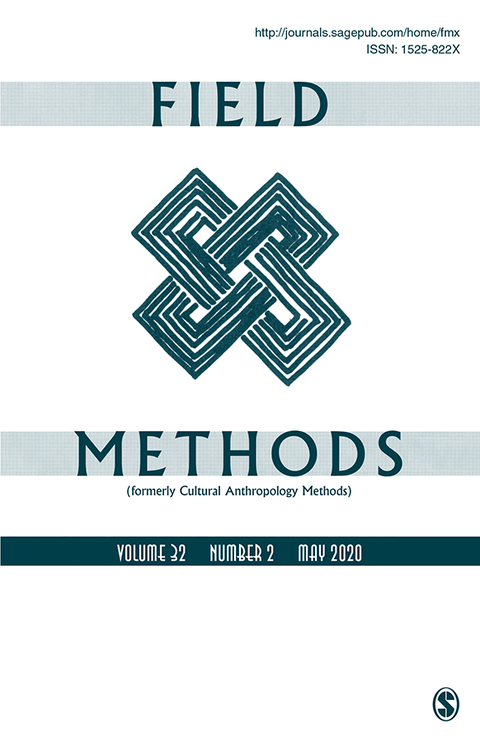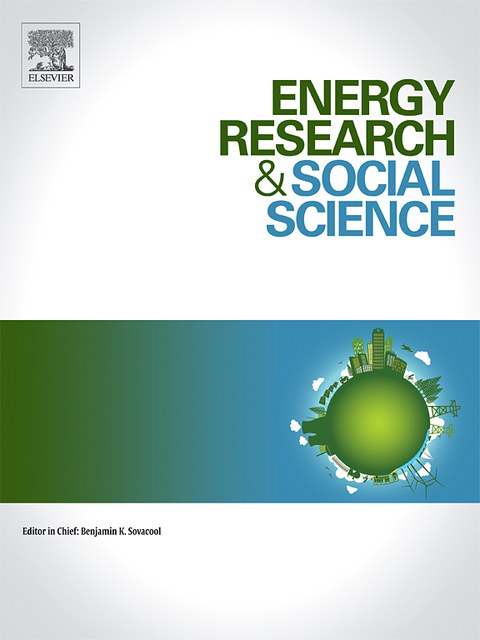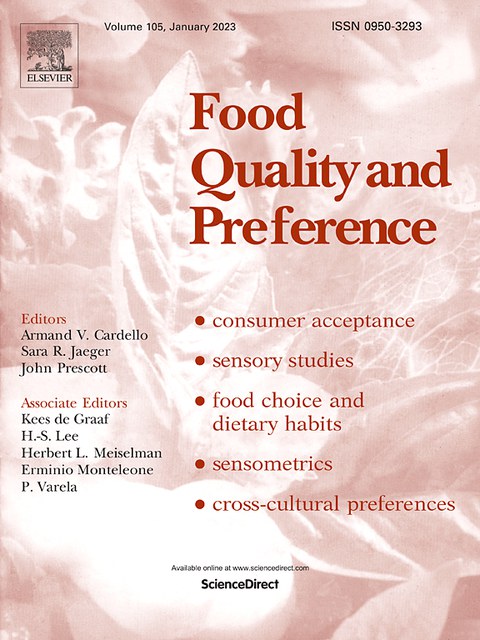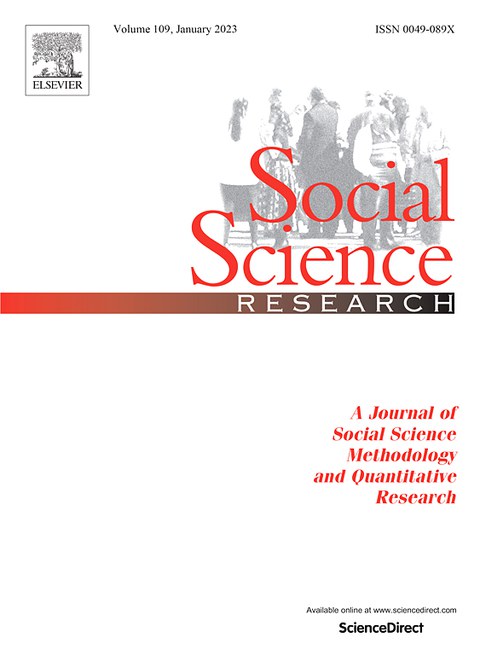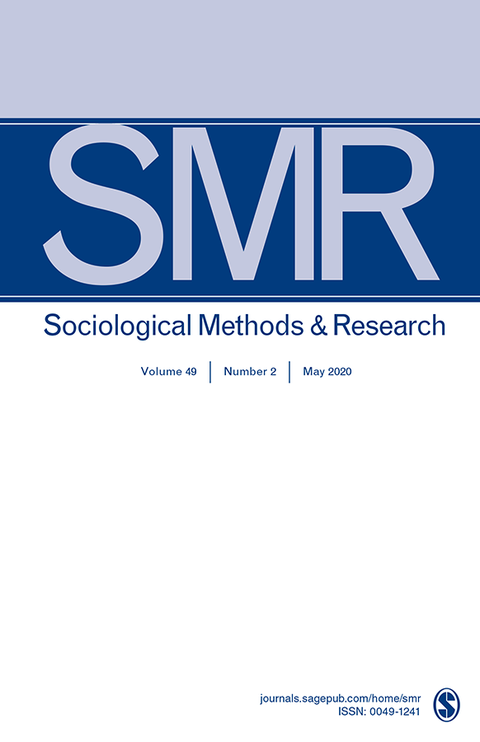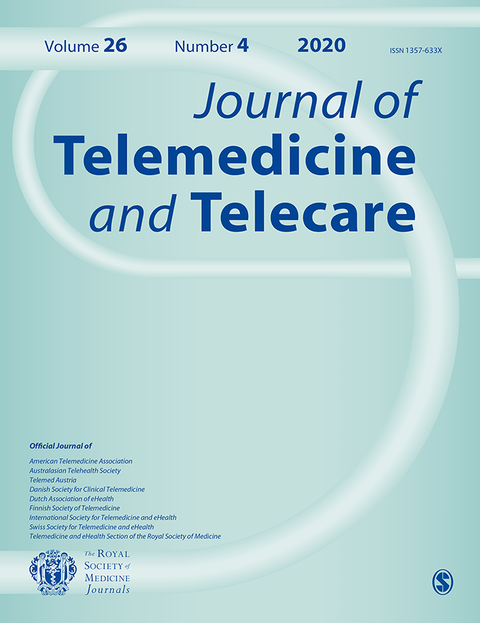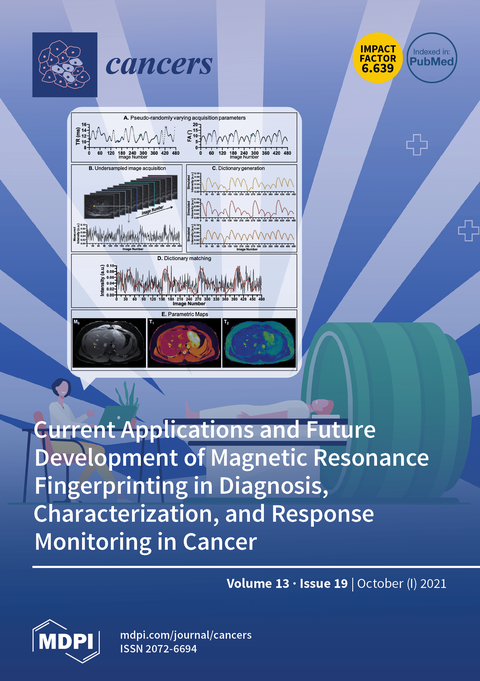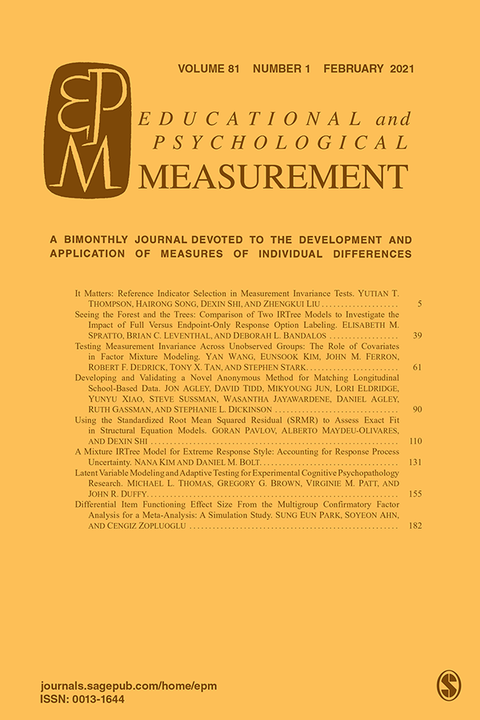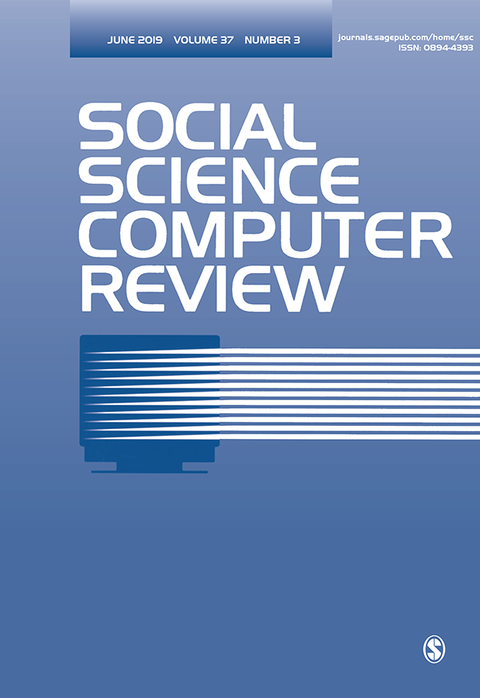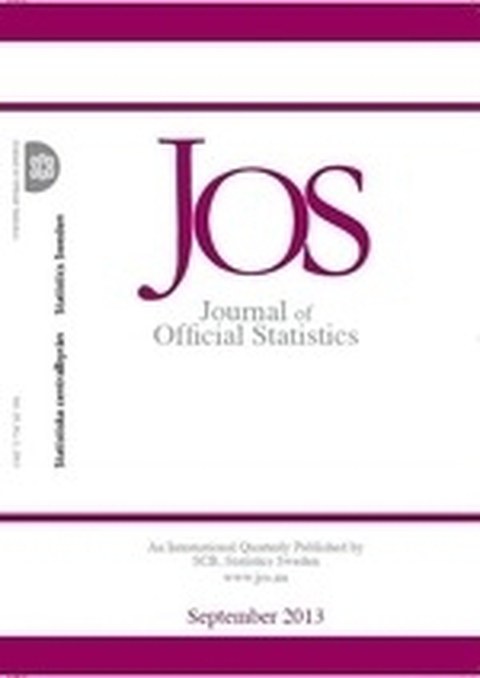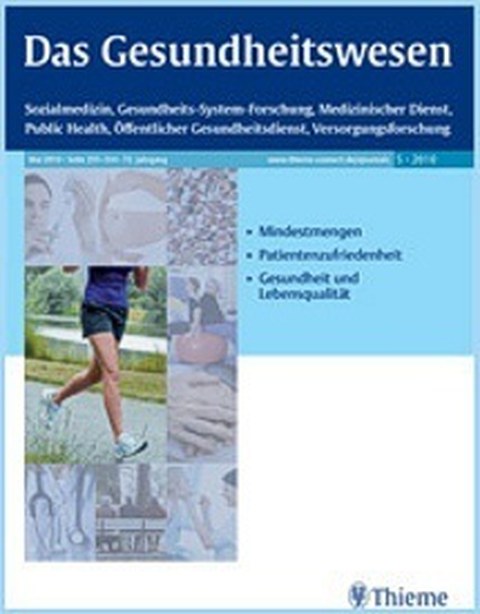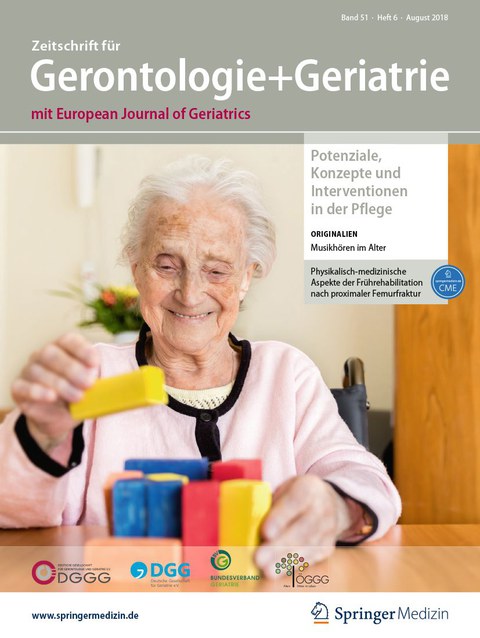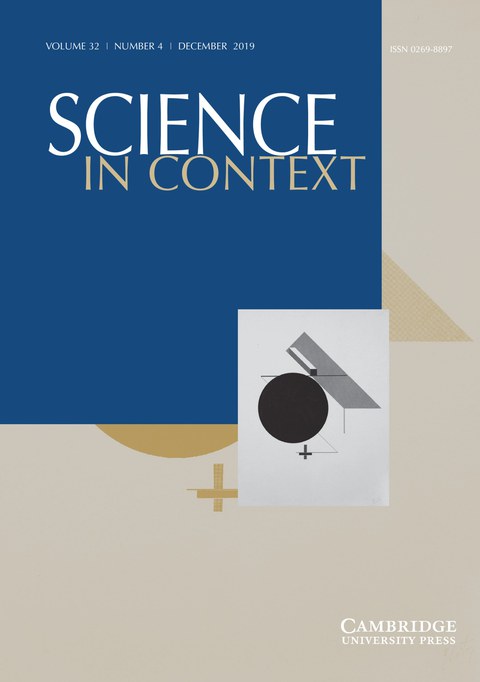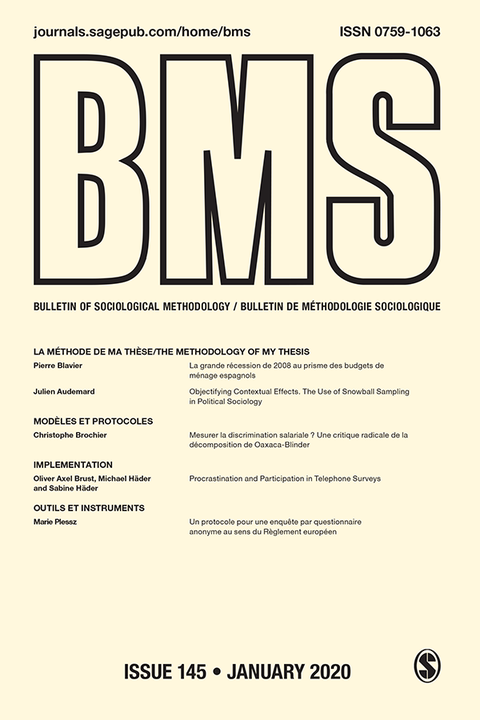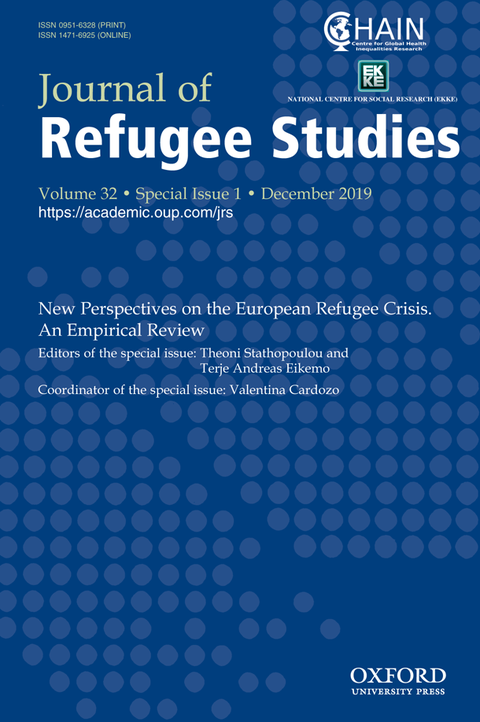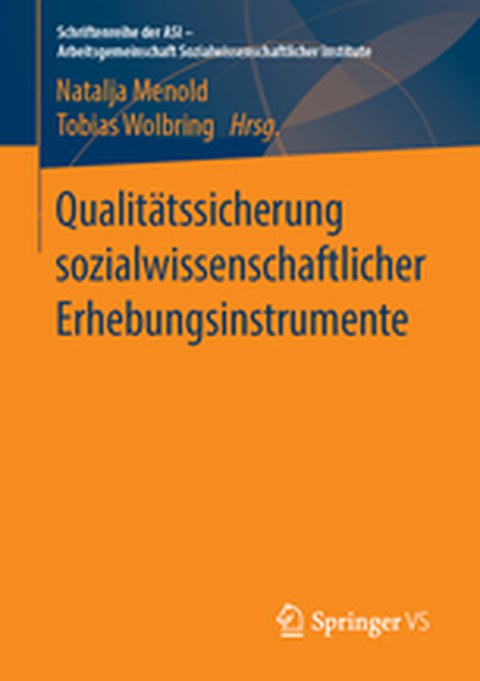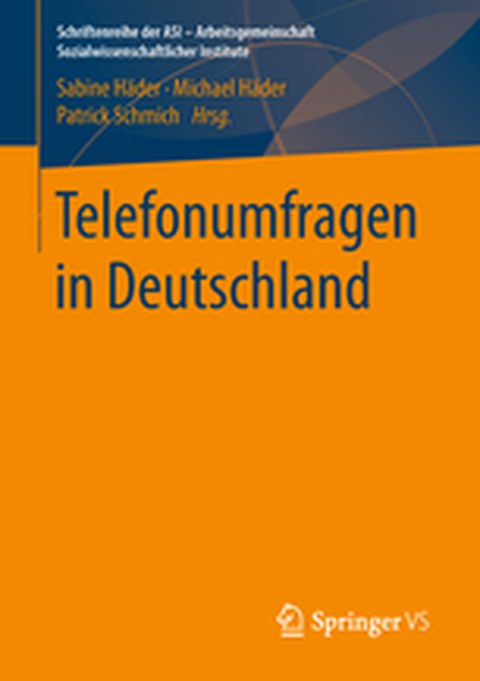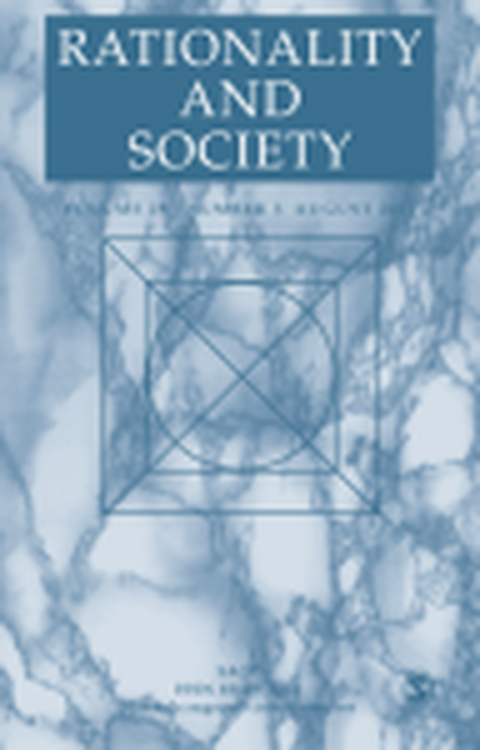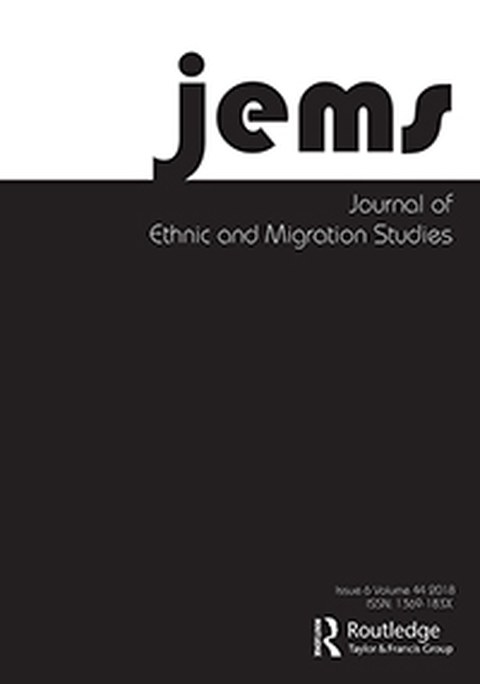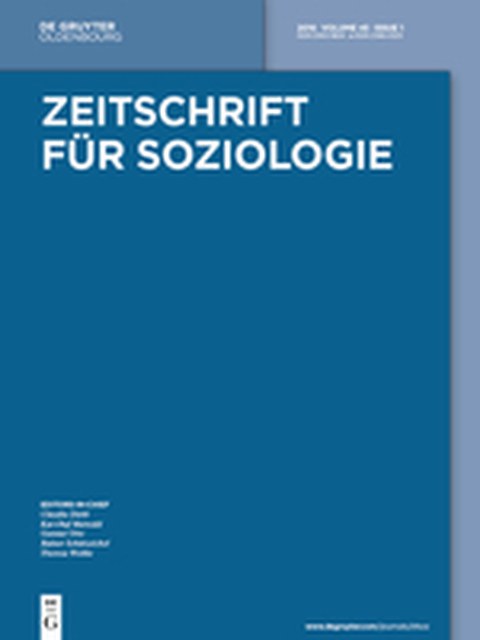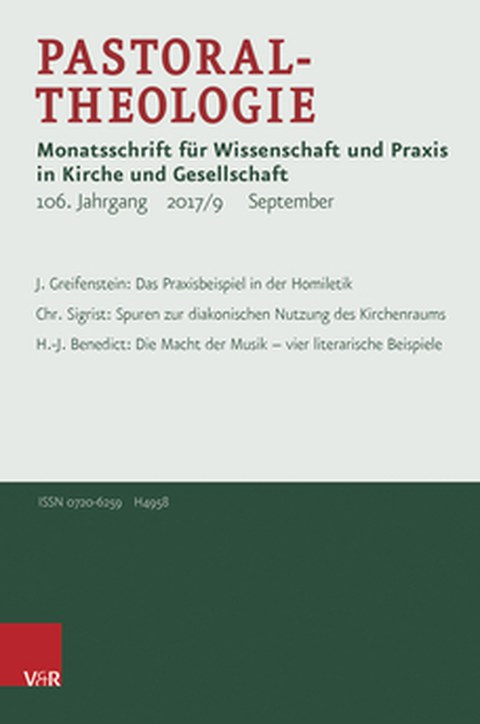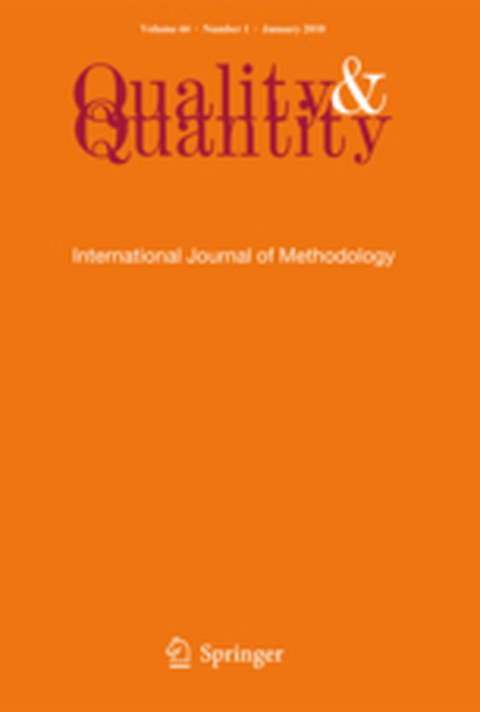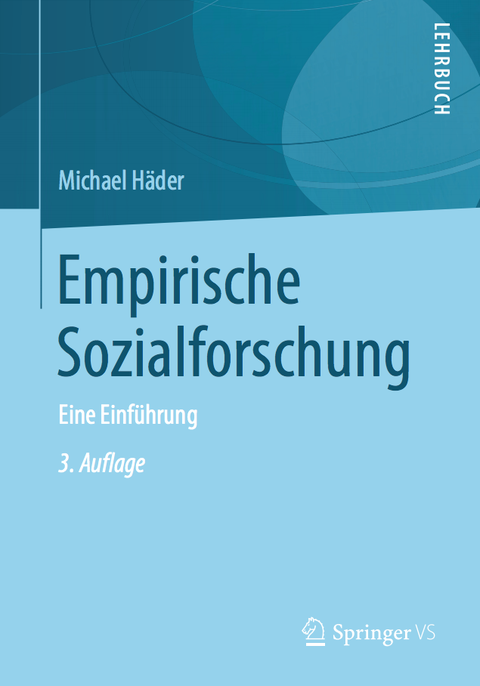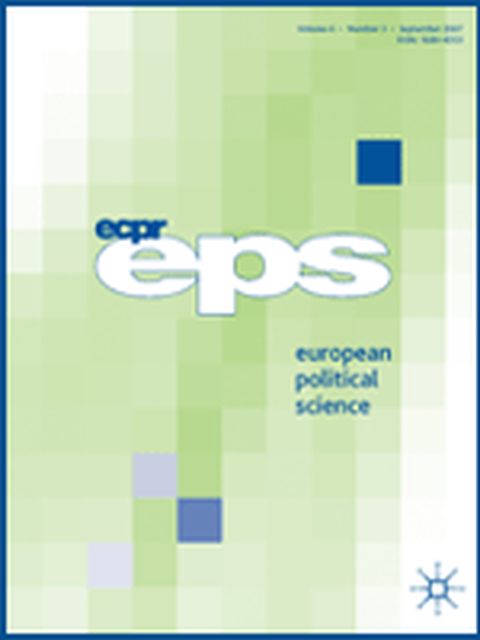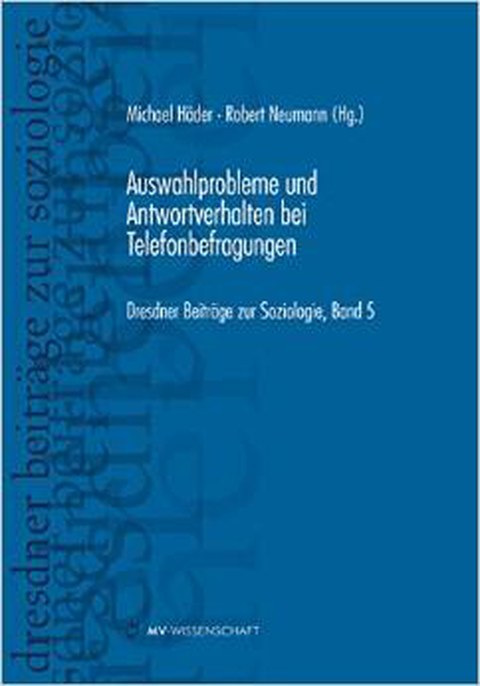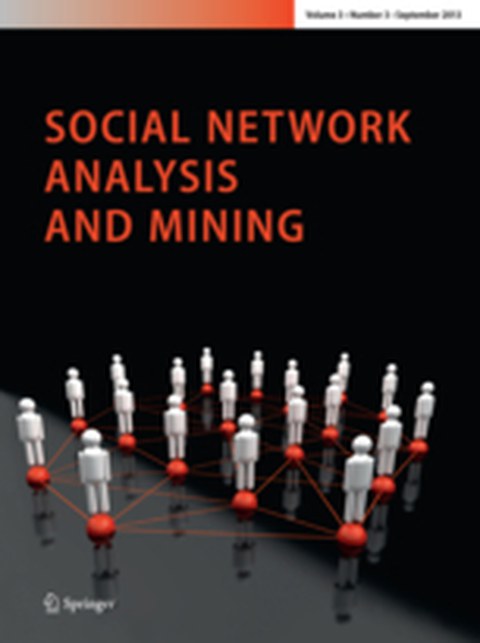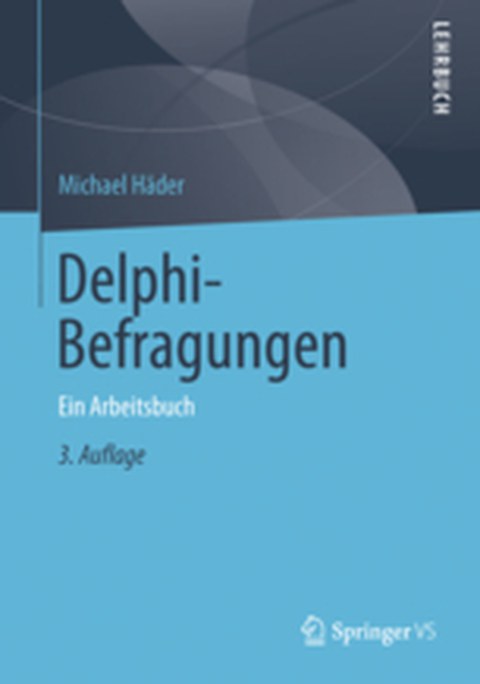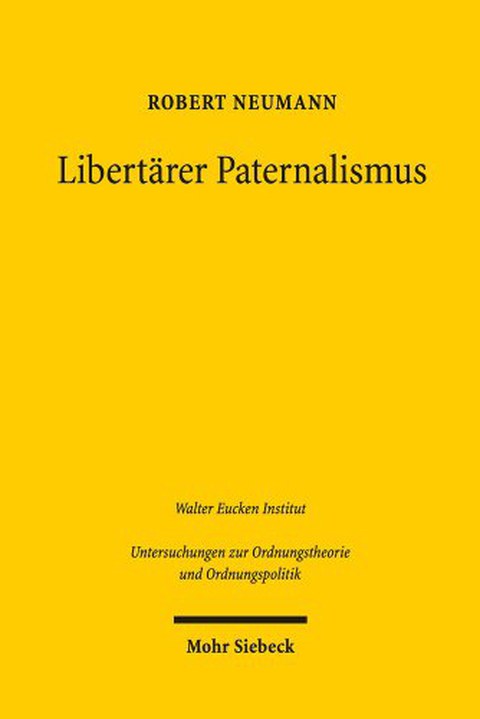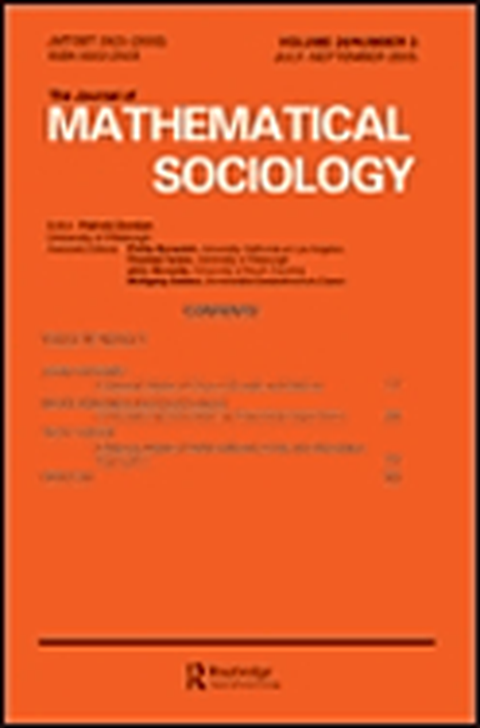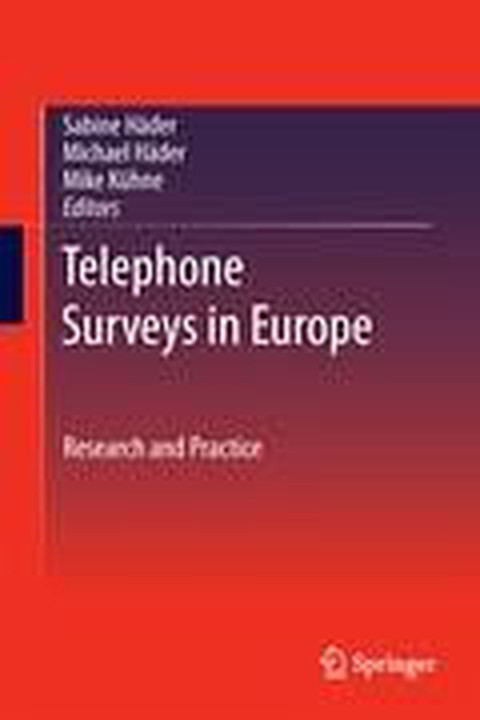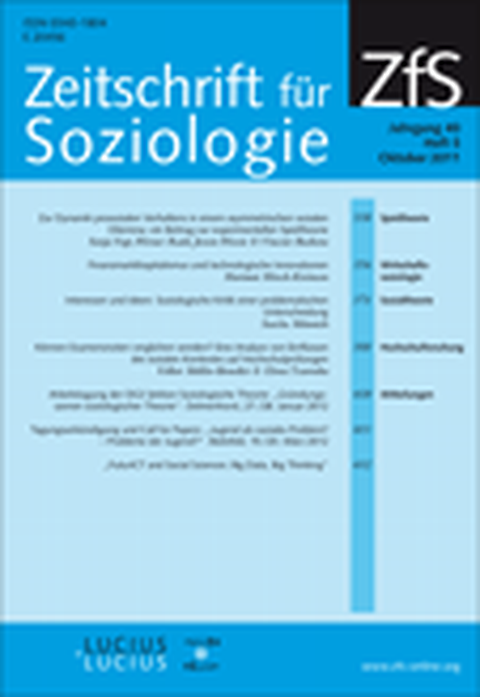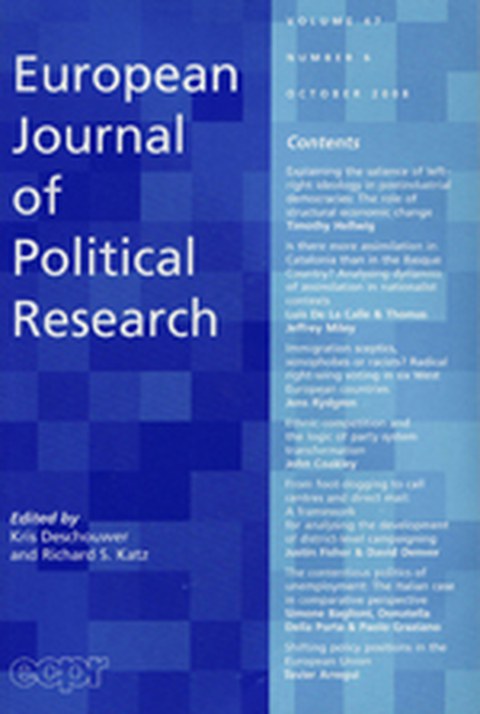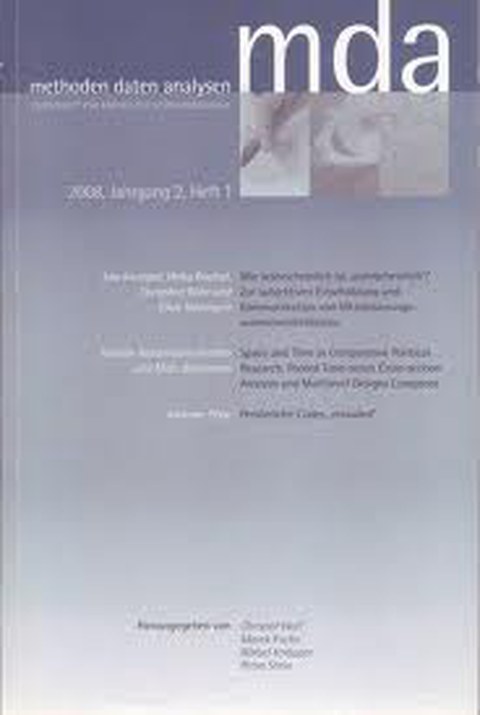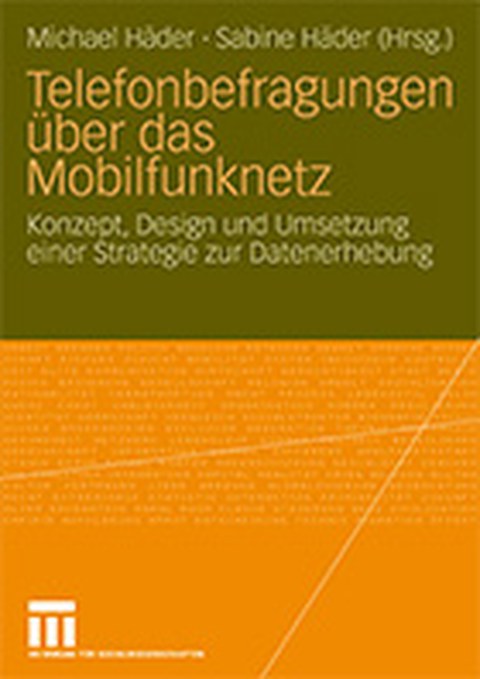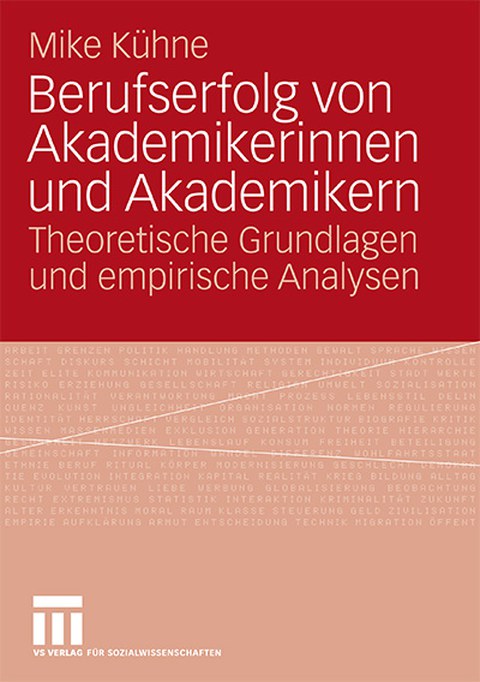Publications
Jenny Bethäuser, Natalja Menold, Peter Winker. 2025.
How survey results are reported in the media: A framework on selection mechanisms and a pilot study on reporting practice. PLoS One 20(10): e0333066. https://doi.org/10.1371/journal.pone.0333066
Survey results are frequently reported in the media without sufficient background information to assess their methodological quality. This gap may arise from various factors, including a lack of statistical literacy among those involved in generating or disseminating results, time and space constraints in journalistic contexts, or the perception that methodological details may overwhelm or confuse audiences. In addition, economic (dis)incentives in the media landscape can affect how journalists decide what to include or leave out when reporting on survey results. We propose a conceptual framework for these factors and their interactions and outline their expected implications for the communication of survey-based findings in public discourse. This framework serves as the foundation for a subsequent empirical pilot study focused on reporting in DER SPIEGEL and BILD. We collected articles published in the second half of 2023 that include the key word 'survey'. We performed a manual content analysis to determine the background information provided on the survey methodology when referring to the survey results. We found that the source of the survey is the most frequent and often the only information on survey background provided. The proposed framework could serve as the foundation for a subsequent broader empirical analysis aimed at identifying the main drivers that influence media reporting on survey statistics and guiding improvements in statistical literacy and reporting practices.
Robert Neumann, Oliver Brust, Jasmin Kadel, Hagen von Hermanni, Natalja Menold. 2024.
Scientific advice and the COVID-19 pandemic: Revisiting the asian disease problem.
International Journal of Public Opinion Research 36(2) https://doi.org/10.1093/ijpor/edae021
The COVID-19 pandemic has underscored the importance of scientific knowledge and highlighted the challenge for politicians: They had to rely on expert advice and still had to make decisions under uncertainty due to the lack of long-term health data. This article investigates how expert judgments and expert advice affect the choices between programs that are proposed to combat the outbreak of a viral disease by means of a between-subjects design embedded in a survey. We use the classic Asian disease experiment and extend earlier applications by varying the professional background of the experts (virologists vs. social scientists) within the experimental set-up. We use data from a university wide web-survey to show the persistence of framing effects and that the disciplinary background of the expert is not related to individual decision making under risk.
Guido Mehlkop, Robert Neumann, Hagen von Hermanni. 2023.
Privacy and the acceptance of centralized digital currencies in the U.S., India and Germany. Scientific Reports 13:8772 https://doi.org/10.1038/s41598-023-35905-y
National governments around the world increasingly acknowledge the possibility of introducing new digital forms of money and implementing policies that trigger their adoption. Knowledge about the acceptance of such measures, however, is rather limited. Next to the regulatory uncertainty about the impact of a Central Bank Digital Currency (CBDC) on competition, on financial stability and questions on the integrity and technical implementations of a CBDC, recent announcements of the joint venture of e.g. the European Central Bank with a large and globally operating private company emphatically raise questions about data privacy. Therefore, we report results of a survey experiment conducted in the United States of America, Germany and India to investigate the acceptance of an app-based monthly digital payment similar to a Universal Basic Income and investigate its adoption across income levels. Controlling for privacy features and short-term vs. long-term incentives to adopt the digital payment app, we find strong reservations with regard to the involvement of multinational tech companies in establishing new digital mediums of exchange, while also finding contextual differences in acceptance levels between the studied populations.
Natalja Menold
Verbalization of Rating Scales Taking Account of Their Polarity.
Field Methods. Online First. https://doi.org/10.1177/1525822X231151314
While numerical bipolar rating scales may evoke positivity bias, little is known about the corresponding bias in verbal bipolar rating scales. The choice of verbalization of the middle category may lead to response bias, particularly if it is not in line with the scale polarity. Unipolar and bipolar seven-category rating scales in which the verbalizations of the middle categories matched or did not match the implemented polarity were investigated in randomized experiments using a non-probabilistic online access panel in Germany. Bipolar rating scales exhibited higher positivity bias and acquiescence than unipolar rating scales. Reliability, validity, and equidistance tended to be violated if the verbalizations of the middle category did not match scale polarity. The results provide a rationale for rating scale verbalization.
Robert Neumann, Guido Mehlkop. 2023.
Neutralization strategies account for the concern-behavior gap in renewable energy usage - Evidence from panel data from Germany.
Energy Research & Social Science 99: 103041 https://doi.org/10.1016/j.erss.2023.103041
Environmental concern in the form of pro-environmental attitudes and normative expectations often serve as explanatory variables of pro-environmental behavior, but the evidence on their impact on pro-environmental action remains inconclusive. Instead of focusing under which conditions individuals reveal their preferences for environmentalism (e.g. only in low cost situations), this article provides empirical evidence for the role of neutralization techniques to account for the lack of pro-environmental actions. We use representative panel data on renewable energy usage from a total of five panel waves collected in Germany during the years 2015 to 2019 to show that neutralizations moderate the effects of both environmental concerns and normative expectations of families and peers. For individuals who have learned neutralization techniques, neither environmental concerns nor normative expectations play a role as determinants of renewable energy usage. Therefore, the availability and salience of such neutralization techniques can contribute to the explanation of the concern-behavior gap.
Robert Neumann, Guido Mehlkop. 2023.
Revisiting farmers markets - Disentangling preferences and conditions of food purchases on countrywide data from Germany,
Food Quality and Preference, 106 https://doi.org/10.1016/j.foodqual.2023.104815
Purchasing food at farmers markets (FMs) has seen increasing popularity over the last decades due to assumed locality, short supply chains and seasonality of food products that together may reduce the ecological footprint of private consumers. But the empirical evidence about the motivations for and barriers to purchasing food products at FMs is often based on data from small samples with regional focus assessed at one point in time and therefore depict only an incomplete picture of the true nature of the underlying preferences. This study uses two mixed-mode surveys to overcome these disadvantages and puts special emphasis on the analysis of the behavioral mechanism that influences the decisions to reveal individual preferences for food purchases at FMs. In particular, our main analysis uses four waves of the GESIS panel, a probability-based access panel representative of the population of Germany. We are able to use repeated measures of purchasing decisions and model the impact of situational opportunity structure, internal constraints as well as social expectations while controlling for seasonal variation in consumer behavior. We find that behavioral costs are of utmost importance when preferences for local and sustainable food products are to be revealed at FMs, while social expectations appear to be more important drivers for purchasing decisions at FMs than internal constraints such as environmental attitudes or health concerns.
Heinz Leitgöb, Daniel Seddig, Tihomir Asparouhove, Dorothée Behr, Eldad Davidov, Kim De Roover, Suzanne Jak, Katharina Meitinger, Natalja Menold, Bengt Muthén, Maksim Rudnev, Peter Schmidt, Rens van de Schoot. 2023.
Measurement invariance in the social sciences: Historical development, methodological challenges, state of the art, and future perspectives.
Social Science Research.
https://doi.org/10.1016/j.ssresearch.2022.102805
This review summarizes the current state of the art of statistical and (survey) methodological research on measurement (non)invariance, which is considered a core challenge for the comparative social sciences. After outlining the historical roots, conceptual details, and standard procedures for measurement invariance testing, the paper focuses in particular on the statistical developments that have been achieved in the last 10 years. These include Bayesian approximate measurement invariance, the alignment method, measurement invariance testing within the multilevel modeling framework, mixture multigroup factor analysis, the measurement invariance explorer, and the response shift-true change decomposition approach. Furthermore, the contribution of survey methodological research to the construction of invariant measurement instruments is explicitly addressed and highlighted, including the issues of design decisions, pretesting, scale adoption, and translation. The paper ends with an outlook on future research perspectives.
Luise Richter, Sophie Pauge, Katja Mehlis, Bastian Surmann, Andrea Züger, Viktoria Mathies, Thomas Ernst, Wolfgang Greiner, Natalja Menold, Eva C. Winkler. 2022.
Financial Effects of a Tumor Disease - Development and Validation of a Patient Reported Outcome Measure in Germany: Study Protocol.
Zenodo. DOI: https://zenodo.org/doi/10.5281/zenodo.6868182
Financial toxicity as an individual consequence of a cancer diagnosis currently evolves to a clinically relevant patient-reported outcome, as several US studies showed that financial burden from cancer patients could impact the quality of life and mortality significantly. However, there is only limited data about financial burden on patients from universal healthcare countries and, in particular, Germany. One reason for this is the lack of a standardized and validated German-language survey instrument to measure financial toxicity precisely. This study aims to develop such an appropriate instrument.
Natalja Menold, Vera Topoel. 2022.
Do Different Devices Perform Equally Well with Different Numbers of Scale Points and Response Formats? A test of measurement invariance and reliability.
Zenodo. DOI: https://doi.org/10.1177/00491241221077237
Research on mixed devices in web surveys is in its infancy. Using a randomized experiment, we investigated device effects (desktop PC, tablet and mobile phone) for six response formats and four different numbers of scale points. N = 5,077 members of an online access panel participated in the experiment. An exact test of measurement invariance and composite reliability were investigated. The results provided full data comparability for devices and formats, with the exception of continuous Visual Analog Scale (VAS), but limited comparability for different numbers of scale points. There were device effects on reliability when looking at the interactions with formats and number of scale points. VAS, use of mobile phones and five point scales consistently gained lower reliability. We suggest technically less demanding implementations as well as a unified design for mixed-device surveys. Link
Caroline Lang, Karen Voigt, Robert Neumann, Antje Bergmann, Vjera Holthoff-Detto. 2022.
Adherence and acceptance of a home-based telemonitoring application used by multi-morbid patients aged 65 years and older.
Journal of Telemedicine and Telecare. 28(1) 37-51
DOI: https://doi.org/10.1177/1357633X20901400
Currently, there are only a small number of comprehensive study results on adherence and acceptance of telemonitoring applications (TMAs) regarding multi-morbid older patients. The ATMoSPHAERE study aimed to develop an information and communication platform for an intersectoral networking of, for example, general practitioners, therapists, social services and the multi-morbid older patient. The study presented was designed as a longitudinal bicentric intervention study which focused on multi-morbid patients aged ≥65 years using home-based telemedical measurement and input devices. The development and testing of this TMA aimed to optimize patients' health care through intersectoral networking of all treating actors. Quantitative methods of data collection and analysis were used. Patients who completed the study were significantly younger than drop-outs and non-participants. The mental health of study patients significantly improved between the beginning and end of TMA use. The main reason for non-participation in the study was the high time expenditure when participating in the study. No perceived (information) benefits for health and insufficient content variety were the main reasons for drop-out. Appropriateness and handling of TMAs must be aligned with the needs of the heterogeneous user group of multi-morbid patients in order to increase acceptance and the added value of TMAs. Telemonitoring hardware should be oriented on functional capabilities of the older target group. Telemonitoring software content requires an individual, disease-specific approach for patients. The TMA should be unobtrusively integrated into usual daily life and be used to an appropriate extent according to the underlying disease in order to avoid stressing patients. With regard to adherence concerning TMAs, it is crucial to provide a contact person who is always available for patients having problems handling TMAs. Health concerns and questions can thus be addressed early, providing a feeling of safety in the care process. User acceptance of TMAs is an essential indicator and driver for use and for future implementation efforts in health care. In order to achieve maximum user centricity in development processes, patients must be involved as experts, co-designers and future users, considering their needs and perception. Link
Sophie Pauge, Bastian Surmann, Katja Mehlis, Andrea Zueger, Luise Richter, Natalja Menold, Wolfgang Greiner, Eva C. Winkler. 2021.
Patient-Reported Financial Distress in Cancer: A Systematic Review of Risk Factors in Universal Healthcare Systems.
Cancers, 13(19), 5015. DOI: https://doi.org/10.3390/cancers13195015
Financial toxicity is a side effect of cancer that results from the perceived financial distress an individual may experience in the course of the disease. The purpose of this paper is to analyze underlying factors related to subjective financial distress in high-income countries with universal healthcare coverage. A systematic literature review was conducted to identify qualitative and quantitative studies of cancer patient-reported subjective financial distress by performing a search in the databases of PubMed, PsycINFO and CINAHL up to December 2020. A qualitative synthesis was performed linking the time-dependent occurrence of risk factors to derived categories of risk factors. Out of 4321 identified records, 30 quantitative and 16 qualitative studies were eligible. Classification of risk factors resulted in eight categories with a total of 34 subcategories. Subjective financial distress is primarily determined by pre-diagnosis sociodemographic factors as well as financial and work factors that might change during the course of the disease. The design of healthcare and social security systems shapes the country-specific degree of subjective financial distress. Further research should focus on evolving multidisciplinary intervention schemes and multidimensional instruments for subjective financial distress to account for identified risk factors in universal healthcare systems more precisely.
Tenko Raykov, Natalja Menold, Jane Leer. 2021.
Evaluation of Second- and Third-Level Variance Proportions in Multilevel Designs With Completely Observed Populations: A Note on a Latent Variable Modeling Procedure.
Educational and Psychological Measurement
DOI: https://doi.org/10.1177/00131644211008643
Two- and three-level designs in educational and psychological research can involve entire populations of Level-3 and possibly Level-2 units, such as schools and educational districts nested within a given state, or neighborhoods and counties in a state. Such a design is of increasing relevance in empirical research owing to the growing popularity of large-scale studies in these and cognate disciplines. The present note discusses a readily applicable procedure for point-and-interval estimation of the proportions of second- and third-level variances in such multilevel settings, which may also be employed in model choice considerations regarding ensuing analyses for response variables of interest. The method is developed within the framework of the latent variable modeling methodology, is readily utilized with widely used software, and is illustrated with an example.
Natalja Menold. 2021.
Response Bias and Reliability in Verbal Agreement Rating Scales: Does Polarity and Verbalization of the Middle Category Matter? Social Science Computer Review, 39(1), 130-147. DOI: 10.1177/0894439319847672
Verbal rating scale polarity and verbalizations of the middle category that do not match the polarity in agreement rating scales were investigated. Two randomized web survey experiments were conducted using a probability panel of German Internet users. The classical bipolar "disagree/agree" verbalization was compared with the unipolar "do not agree/agree" alternative. In both experiments, attitudes on gender roles were measured using a different number of rating scale categories (seven vs. five) in each. After controlling for variables related to satisficing, biases were lowest with the unipolar "do not agree/agree" rating scale in which the verbalization of the middle category was also unipolar. Reliability decreased when the verbalization of the middle category did not suit the rating scale polarity. Researchers should pay attention to the polarity of rating scales and use verbalization of the middle category consistent with the rating scale polarity.
Link
Natalja Menold, Tenko Raykov. 2021.
On the Relationship between Item Stem Formulation and Criterion Validity of Multiple-Component Measuring Instruments
Educational and Psychological Measurement
DOI: https://doi.org/10.1177/0013164420988169
The possible dependency of criterion validity on item formulation in a multicomponent measuring instrument is examined. The discussion is concerned with evaluation of the differences in criterion validity between two or more groups (populations/subpopulations) that have been administered instruments with items having differently formulated item stems. The case of complex item stems involving two stimuli description sentences (double-barreled questions) is thereby compared with the setting where items contained a single sentence. Using empirical data, the latent criterion validity differences are evaluated across three groups that are randomly assigned to conditions characterized by item stems with differing number of stimuli. The results indicate that validity of an instrument can be influenced by the specific way item stem is formulated. Implications for empirical educational, behavioral, and social science research are discussed.
Natalja Menold. 2020.
Double Barreled Questions: An Analysis of the Similarity of Elements and the Measurement Quality
Journal of Official Statistics 36(4): 855-886.
DOI: https://doi.org/10.2478/jos-2020-0041
In double barreled questions (DBQs) respondents provide one answer to two questions. Assumptions how respondents treat DBQs and how DBQs impact measurement quality are tested in two randomized experiments. DBQs are compared with revisions in which one stimulus was retained while the other stimulus was skipped. The observed means and parameters when modeling latent variables differed among the versions. Metric and scalar measurement invariance was not given among the versions, and at least one single stimulus version was found to be associated with a higher validity. Response latencies did not differ among versions or respondents needed less time to respond to DBQs. The author concludes that respondents may understand the stimuli in a DBQ differently, and access one of them while disregarding the other, which can have an adverse effect on validity.
Sven Stadmüller, Natalja Menold, Jette Schröder, Stefan Ehlers. 2020.
Barriers and potential for improvement in the diagnosis and treatment of asylum-seeking tuberculosis patients in Germany - results of a qualitative study
The health care system.
DOI: https://doi.org/10.1055/a-1186-0188
Since 2014, the number of new cases of tuberculosis (TB) in Germany has risen by around 20%. This development coincides with a high influx of asylum seekers, some of whom come from countries where TB is much more widespread than in Germany. Against this background, the aim of this article is to identify and explain barriers to the diagnosis and treatment of asylum-seeking TB patients in Germany. At the same time, potential for improvement in these areas is to be highlighted. The data is based on 14 guided, problem-centered interviews with physicians and public health officials who represent the care providers as experts. On the one hand, structural factors give rise to the obstacles named by the experts. For example, limited access to healthcare leads to delayed diagnosis, as asylum seekers go to the doctor later (or not at all) as a result. Accordingly, a nationwide introduction of an electronic health card is proposed. On the other hand, individual and cultural factors play an important role. These include, for example, language barriers, which make it difficult to take a medical history (and thus make a diagnosis) and, above all, to inform the patient, thus jeopardizing the success of treatment. In addition, the lack of familiarity of asylum seekers with the German healthcare system results in the risk of therapy being interrupted. Training programs based on the "train the trainer" concept and the establishment of a "pilot" who navigates asylum-seeking TB patients through the German healthcare system could alleviate these problems.
Natalja Menold. 2020.
Rating Scale Labeling in Online Surveys: An Experimental Comparison of Verbal and Numeric Rating Scales with Respect to Measurement Quality and Respondents' Cognitive Processes.
Sociological Methods and Research, 49 (1), 79-107. DOI: https://doi.org/10.1177/0049124117729694
Unlike other data collection modes, the effect of labeling rating scales on reliability and validity, as relevant aspects of measurement quality, has seldom been addressed in online surveys. In this study, verbal and numeric rating scales were compared in split-ballot online survey experiments. In the first experiment, respondents' cognitive processes were observed by means of eye tracking, that is, determining the respondent's fixations in different areas of the screen. In the remaining experiments, data for reliability and validity analysis were collected from a German adult sample. The results show that respondents needed more fixations and more time to endorse a category when a rating scale had numeric labels. Cross-sectional reliability was lower and some hypotheses with respect to the criterion validity could not be supported when numeric rating scales were used. In conclusion, theoretical considerations and the empirical results contradict the current broad usage of numeric scales in online surveys. Link
Robert Neumann, Guido Mehlkop. 2020.
Framing electricity plan choices to enhance green energy usage: A choice experiment with panel data from Germany.
Energy Research & Social Science 70. doi: https://doi.org/10.1016/j.erss.2020.101741
This paper investigates the choices and accompanying biases consumers have when actively deciding between two alternative electricity plans. We follow the perspective that observed choices do not necessarily reflect true preferences over outcomes, but are affected by several behavioral tendencies or biases. Our experiment focuses on framing-effects as an important source for such observed behavior. The study is based on data from a large-scale survey experiment conducted in Germany (n = 3320). We implemented a choice experiment in two waves of the GESIS Panel and analyzed more than 16,000 binary decisions between a standard electricity plan and a supply plan based entirely on renewable energy resources. Across two waves, we manipulated the numerical information as to how the additional costs for buying a green energy plan are presented in the decision problem while keeping the monetary consequences identical between the two waves. We show that framing the consequences of a green electricity plan choice as a foregone saving yields higher rates of green choices than framing the choice of green plan as an additional expenditure. We discuss problems and merits related to the policy strategy of actively framing green energy options that extend beyond the German context. Link
Natalja Menold. 2020.
How Do Reverse-Keyed Items in Inventories Affect Measurement Quality and Information Processing.
Field Methods. 32(2) 140-158. doi: https://doi.org/10.1177/1525822X19890827
In randomized experiments, inventories with reverse-keyed items are compared with inventories in which all the items are either positively or negatively associated with the underlying concept. The results show that with reverse keying, a control of the potential bias was not sufficient; likewise, the factorial structure, reliability, and validity were negatively affected. An eye-tracking study revealed that respondents did not process information more deeply with the reverse-keyed items than with the other forms. Respondents seemed to find it difficult to process reverse keying mentally so that it is not sufficient to use it in heterogeneous samples and with short inventories.
Fabian Lenz, Jeannine Schübel, Robert Neumann, Antje Bergmann & Karen Voigt. 2020.
Assessing the care of patients with dementia in general practitioner home visits. Journal of Gerontology and Geriatrics. DOI: https://doi.org/10.1007/s00391-020-01715-4
Dementia patients (DP) are a particular challenge for the healthcare system. They account for 5% of total healthcare expenditure. The disease-related deficits and the associated need for care mean that many patients are no longer able to live in their own homes and are dependent on care in nursing homes (PH). How is the overall care of DP in the home visit (HB) assessed? Does the regional situation influence the housing situation of DPs? As part of SESAM-5, 4286 home visits were documented by 303 GP practices in Saxony over a period of one year using questionnaires and both content-related and structural characteristics were recorded. The prevalence of dementia in HB patients was 27.5%. Of these, 72.6% lived in a PH or assisted living facility. The medical staff rated the overall care of DP in the PH as significantly better than in their own homes. This discrepancy was even more pronounced when comparing rural and urban areas, although significantly more patients in urban areas lived in PH (27% vs. 51%). The care of HB patients with dementia is predominantly rated as good by the staff providing care, with this being rated comparatively better for DPs in PH than in their own homes. This can be explained by the DP's high need for care. The contrast between rural and urban areas can be explained by infrastructural differences, but also by organizational differences in rural areas, where significantly more care is provided by relatives. As cognitive deficits are at the forefront of DP, alternative forms of living could come more into focus in the future. Link
Ulrike Jacob, Oliver Brust. 2020.
Confronting the anomaly: directions in (German) economic research after the crisis. Science in Context 32(4): 449-472. DOI: http: //dx.doi.org/10.1017/S026988972000006X
Recurring economic crises, like the one of 2007-2008, led to criticism of economic research and a demand to develop new strategies to avoid them. Standard economic theories use conventional approaches to deal with economic challenges, heterodox theories try to develop alternatives with which to face them. It remains unclear whether the 2007-2008 crisis led to a change in economic research as well as to a consideration of alternative approaches. We used co-word analysis to map the structure of economic research in Germany between 2005 and 2014. Core topics within economic research, such as "market" or "production" hardly shift and can be linked to standard economic theories. Peripheral topics such as "inequality" or "unemployment" show greater dynamics. However, only a few of these topics can be linked to heterodox approaches. Certain changes have occurred in reaction to the 2007-2008 crisis. However, the unchanged importance of standard economic topics raises the question whether these changes are sufficient to face coming economic challenges.
Link
Oliver Brust, Michael Häder, Sabine Häder. 2020.
Procrastination and Participation in Telephone Surveys. Bulletin of Sociological Methodology/Bulletin de Méthodologie Sociologique 145(1): 80-99. DOI: https: //doi.org/10.1177/0759106319888705
To minimize survey nonresponse, psychological characteristics of respondents should be taken into consideration. One characteristic that could be related to survey response is procrastination, that is, the tendency to delay intended and necessary important activities. We applied exploratory factor analysis and IRT analysis to assess the dimensionality, reliability, and validity of a short procrastination scale (PFS-4, see Glöckner-Rist et al., 2014) in a general population telephone survey in Germany. Furthermore, we used logistic regression to determine what activities were interrupted in order to participate in the survey and whether procrastination played a role in this regard. Procrastination can be measured economically and easily in telephone surveys and is an important predictor of survey participation when individuals are engaged in work activities or satisfying basic needs when they are called. This knowledge may help to develop strategies to further reduce nonresponse in population surveys conducted on landline and mobile phones.
Link
Theoni Stathopoulou, Elica Krajčeva, Natalja Menold. 2019.
Questionnaire design and translation for refugee populations: Lessons learned from the REHEAL Study. Journal of Refugee Studies, 32(Special_Issue_1), i105-i121. doi: https://doi.org/10.1093/jrs/fez045
Surveying the refugee population poses particular challenges: what measurement and culture effects need to be taken into account? Are some of the constructs related to refugees unique or can constructs used in other surveys be adapted? Due to considerable variation in educational background, in trauma history or in perception of ethnicity or gender roles in refugee populations, one needs to raise the question whether a one-size-fits-all approach is suitable when designing a questionnaire for refugee populations. Drawing upon the experience of the REHEAL study conducted in 2016 during the early phase of refugees' settlement in Greek refugee camps, the article addresses the particular challenges when designing and translating a questionnaire for multinational, multicultural and potentially traumatized refugee populations, residing in refugee accommodation settings. A post hoc scrutiny of the Arabic and Farsi versions of the REHEAL questionnaire forms the basis of this article in order to empirically inform best practices in designing and translating questionnaires for special populations. The authors set the stage by summarizing key aspects of concept and measurement equivalence in cross-cultural research, and then by expanding on the fact that cross-cultural differences in response styles or response sets can affect comparability. Translation and adaptation challenges are examined and illustrated by examples. This article serves to empirically document the benefit and pitfalls of appropriate measurements for use in refugee research. Link
Louise Biddle, Natalja Menold, Martina Bentner, Stefan Nöst, Rosa Jahn, Sandra Ziegler, Kayvan Bozorgmehr. 2019.
Health monitoring among asylum seekers and refugees: a statewide, cross-sectional, population-based study in Germany. Emerging Themes in Epidemiology, 16(1), 3. DOI: https://doi.org/10.1186/s12982-019-0085-2
Health monitoring in Germany falls short on generating timely, reliable and representative data among migrants, especially transient and marginalized groups such as asylum seekers and refugees (ASR). We aim to advance current health monitoring approaches and obtain reliable estimates on health status and access to essential healthcare services among ASR in Germany's third largest federal state, Baden-Württemberg. Methods: We conducted a state-wide, cross-sectional, population-based health monitoring survey in nine languages among ASR and their children in collective accommodation centers in 44 districts. Questionnaire items capturing health status, access to care, and sociodemographic variables were taken from established surveys and translated using a team approach. Random sampling on the level of 1938 accommodation centers with 70,634 ASR was employed to draw a balanced sample of 65 centers with a net sample of 1% of the state's ASR population. Multilingual field teams recruited eligible participants using a "door-to-door" approach. Parents completed an additional questionnaire on behalf of their children. Results: The final sample comprised 58 centers with 1843 ASR. Of the total sample expected eligible (N = 987), 41.7% (n = 412) participated in the survey. Overall, 157 households had children and received a children's questionnaire; 61% (n = 95) of these were returned. Age, sex, and nationality of the included sample were comparable to the total population of asylum applicants in Germany. Adults reported longstanding limitations (16%), bad/very bad general health (19%), pain (25%), chronic illness (40%), depression (46%), and anxiety (45%). 52% utilized primary and 37% specialist care services in the previous 12 months, while reporting unmet needs for primary (31%) and specialist care (32%). Younger and male participants had above-average health status and below-average utilization compared to older and female ASR. Conclusions: Our health monitoring survey yielded reliable estimates on health status and health care access among ASR, revealing relevant morbidities and patterns of care. Applying rigorous epidemiological methods in linguistically diverse, transient and marginalized populations is challenging, but feasible. Integration of this approach into state- and nation-wide health monitoring strategies is needed in order to sustain this approach as a health planning tool. Link
Natalja Menold, Tobias Wolbring (eds.). 2019.
Quality assurance of social science survey instruments. Springer VS.
The quality of social science survey instruments has a significant influence on the robustness of empirical conclusions drawn on the basis of survey data. This volume therefore focuses on the quality of survey instruments and procedures for determining and improving their quality.
In particular, topics of questionnaire construction, qualitative techniques for pretesting, approaches to response validity and design issues of quality management for surveys in practice are dealt with in depth. Link
Sabine Häder, Michael Häder, Patrick Schmich (eds.). 2019.
Telephone surveys in Germany. Springer VS.
This book provides an overview of the current state of research in the field of telephone surveys. The authors' aim was to provide both scientific researchers with a compact overview and institutions considering telephone surveys with concrete tips for implementation. The aim is to provide good practice guidelines in the sense of proven procedures and recommendations based on practical experience. Readers are offered assistance in finding out about the necessary steps, starting with the invitation to tender for a study, through the relevant aspects of questionnaire design and understanding the selection strategy, to the content of the method reports. The book's central theme is the classification of the various phases of telephone surveys with the aim of reducing total survey error (TSE). Link
*Robert Neumann. 2019.
The framing of charitable giving - a field-experiment at bottle refund machines in Germany. Rationality& Society 31(1): 98-126.
This paper investigates the decision of consumers at bottle refund machines to either reclaim their bottle deposit or to donate the refund to a non-profit organization. The study documents the unique pre-intervention data on donating behavior and introduces a field experiment to increase donation levels. The design comprised the strategic framing of the situation by highlighting different cues about the normative, descriptive and local expectations of charitable giving as well as cues about the warm glow of donating money. The experiment took place in twenty supermarkets in Germany and lasted for twelve months. By varying the experimental design and using different modeling approaches, the study arrives at the conclusion that individuals largely act consistent with the assumption having self-regarding preferences that are stable and difficult to change. Hence, our pre-test and post-intervention data stands in sharp contrast to results from lab-experiments.
*Hagen von Hermanni, Robert Neumann. 2019.
Refugees welcome? The interplay between perceived threats and general concerns on the acceptance of refugees - a factorial survey approach in Germany,
Journal of Ethnic and Migration Studies 45(3): 349-374. DOI: online first
The on-going migration of refugees to Europe has fueled debates about the indigence of refugees and the perceived legitimacy of individual claims for asylum in different receptive countries. With a substantial body of research that has investigated the antecedents of attitudes towards immigrants, evidence on whether those underlying assumptions hold true for refugees as well remains scarce. The paper applies the framework of Intergroup Threat Theory to arrive at competing hypotheses with regard to the acceptance levels of refugees. We use pooled data from two probabilistic samples drawn in the German city of Dresden and apply a confounded factorial survey design to extend previous research on attitudes towards refugees. We find that natives perceive political persecution and war as justified reasons for seeking asylum in Germany, while socio-demographic characteristics of respondents and refugees are of minor importance. Foremost, the individual level of respondent's fear of crime represents a crucial moderator of the perception of refugees as threatening.
*Robert Neumann, Guido Mehlkop. 2018.
Environmental decisions as an interplay of attitudes, costs of action and situational framing - an empirical comparison of theories with data from the GESIS Panel.
Journal of Sociology 47(2): 101-118.
Various theoretical approaches attempt to explain the relationship between individual environmental attitudes and environment-related behavior in everyday decisions. The low-cost hypothesis as well as dual process models in general and the frame selection model in particular assume different causal relationships for the interplay between environmental attitudes and decision costs. By including sequential decision situations in current population surveys, this article aims to empirically enrich the theoretical debate on the appropriate explanation of environmental decisions. To this end, we use data from two waves of the GESIS panel. Although empirical evidence for both explanatory approaches can be found with the help of multilevel analyses, we also find partially inconsistent results for the predictions of both theories depending on the situational framing of the decision.
Michael Häder, Jan Hermelink (eds.). 2017.
Empirical theology of the ephoral ministry.
Pastoraltheologie - Monatsschrift für Wissenschaft und Praxis in Kirche und Gesellschaft 106(7).
This special issue presents the results, analyses and theological interpretations of a survey conducted in fall 2015 among those involved in the middle management level of Protestant regional churches in Germany.
*Oliver A. Brust, Sabine Häder, Michael Häder. 2016.
Is the Short Version of the Big Five Inventory (BFI-S) Applicable for Use in Telephone Surveys?
Journal of Official Statistics 35(2): 601-618.
The inclusion of psychological indicators in survey research has become more common because they offer the possibility of explaining much of the variance in sociological variables. The Big Five personality dimensions in particular are often used to explain opinions, attitudes, and behavior. However, the short versions of the Big Five Inventory (BFI-S) were developed for face-to-face surveys. Studies have shown distortions in the identification of the Big Five factor structure in subsamples of older respondents in landline telephone surveys. We applied the same BFI-S but with a shorter rating scale in a telephone survey with two subsamples (landline and mobile phone). Using exploratory structural equation modeling (ESEM), we identified the Big Five structure in the subsamples and the age groups. This finding leads us to conclude that the BFI-S is a powerful means of including personality characteristics in telephone surveys.Article
*Robert Neumann. 2016.
Understanding trustworthiness: using response latencies from CATI surveys to learn about the "crucial" variable in trust research.
Quality & Quantity 50(1): 43-64.
Research on trustworthiness and trust behavior so far has followed different methodological approaches and has generated conflicting evidence regarding their interrelationships. While several authors follow the definition of trustworthiness as a belief or a formed expectancy by Person A about Person B to do X (usually to reward trust), different hypotheses can be derived regarding its formation, depending on whether one treats trustworthiness as incentive-based or as a propensity or disposition. Furthermore, distinct measurement approaches for trustworthiness exist, depending on the mode of data collection. With theoretical claims that trustworthiness represents "the crucial variable" (Hardin in Trust, 2006) for understanding and explaining successful cooperation based on trust, the article proposes the use of para-data in the form of response latency measurement to enhance the understanding of the thought processes behind forming an assessment of trustworthiness. The study uses pooled data from two CATI surveys conducted in Germany in 2012 to test hypotheses on the underlying cognitive process of forming an expectation of trustworthiness by applying the techniques of both response latency measurement and Cox regression models. We find that the applied survey measures of trustworthiness generate inconsistent results regarding the underlying process of forming expectations. Consequences for future research are discussed. Article
Michael Häder. 2015.
Empirical Social Research - An Introduction (3rd, revised edition).
Wiesbaden: Springer Press.
Social science methods such as surveys, observations and content analyses are used in market research, contemporary history studies, urban planning and communication research. They are even more needed by sociologists and empirical political scientists. Whether in the context of evaluating a prevention program or for surveying health behavior or for a study on social mobility, the safe handling of social science instruments is always a prerequisite for achieving reliable results. This book provides important information for users and developers of these instruments. It covers the theoretical foundations of the methods, the steps involved in designing and implementing a project, the many different ways of collecting data, the methods to be used when selecting the units of investigation and the principles to be observed when evaluating and documenting the findings. Numerous examples are used to provide a particularly clear presentation. link
Robert Neumann & Peter Graeff (eds.) 2015.
Quantitative approaches to comparative analyses - Special Issue. European Political Science 14(4). Basingstoke: PalgraveMacMillan.
While there is an abundant use of macro data in the social sciences, little attention is given to the sources or the construction of these data. Owing to the restricted amount of indices or items, researchers most often apply the 'available data at hand'. Since the opportunities to analyze data are constantly increasing and the availability of macro indicators is improving as well, one may be enticed to incorporate even qualitatively inferior indicators for the sake of statistically significant results. The pitfalls of applying biased indicators or using instruments with unknown methodological characteristics are biased estimates, false statistical inferences and, as one potential consequence, the derivation of misleading policy recommendations. This Special Issue assembles contributions that attempt to stimulate the missing debate about the criteria of assessing aggregate data and their measurement properties for comparative analyses. Link
Michael Häder & Robert Neumann (eds.) 2014.
Selection problems and response behavior in telephone surveys.
Dresdner Beiträge zur Soziologie Volume 5. Münster: Verlagshaus Monsenstein & Vannerdat.
The articles in this volume address methodological problems of telephone surveys in two different areas. The studies on selection problems examine the widespread strategies of making a random selection of individual households and then of persons in the households on the basis of existing entries in telephone directories. The complex of response behavior in mobile and landline surveys includes studies on how hypotheses on response quality can be tested with the technical aid of response reaction time measurement and with information on the personality traits of respondents. The volume thus addresses some of the current methodological challenges of telephone surveys in ensuring the quality of the data collected under the condition of a constantly decreasing willingness to participate. Link
Mathias Kuhnt, Oliver Brust. 2014.
Low reciprocity rates in acquaintance networks of young adults - Fact or artifact?
Social Network Analysis and Mining 4: 167.
Empirical studies often report low rates of reciprocity in acquaintance networks. These results, however, are not supported by theoretical assumptions according to which full reciprocity should be assured. To investigate this contradiction, we carried out a full network survey in two longitudinal datasets (N= 213 and N= 197) and identified possible predictors for reciprocity and their development over time. Therefore, we introduce a distinction between active and passive reciprocity. We evaluate indicators for both, perceptional errors and factual direct- edness of links as possible causes for low rates of reciprocity. Results include the following: Reciprocity does not increase with the strength of the relation. Mutual links are much more stable over time. Personality traits show to influences on active and passive reciprocity. Implications of our findings are discussed. There is evidence that crucial differences exist between mutual and non-reciprocated links and that the network integration of an actor is represented rather by the mutual links than by all of the ties. Link
Michael Häder. 2014.
Delphi surveys: A workbook. 3rd edition. Springer VS.
Since the mid-1990s, Delphi surveys have become increasingly important in politics and business. They make it possible to generate valid assessments of an issue that is per se unclear - for example, the future of the Internet. To this end, experts are asked for their opinions in a multi-stage, anonymous process, which leads to more competent judgments. This book is an introduction to and workbook for conducting Delphi surveys. The author provides instructions for the adequate design of the four established survey types (aggregation of ideas, structuring of a diffuse issue, qualification of expert opinions, creation of a consensus among the experts) and presents important aspects of the procedure in detail. In addition, the volume provides the theoretical foundation of the procedure often demanded by critics, based on cognitive psychological considerations and empirical findings on the evaluation of the Delphi approach. Numerous annotated bibliographical references provide the interested reader with access to further information in a targeted manner. link
Robert Neumann. 2013.
Libertarian Paternalism - Theory and Empiricism of State Decision Architecture.
UOrd 66. Tübingen: Mohr Siebeck.
Libertarian paternalism refers to a form of state coordination in which the limits of human rationality are overcome and developments desirable for society as a whole are favored without restricting the civil liberties of citizens. Using the example of German family policy, Robert Neumann discusses the opportunities and risks of this new regulatory concept. Link
Robert Neumann, Peter Graeff. 2013.
Method bias in comparative research: Problems of construct validity as exemplified by the measurement of ethnic diversity.
Journal of Mathematical Sociology 37(2):85-112.
This study investigates indices of ethnic diversity for method effects due to differences in operationalization. It adapts the methodology of Multitrait-Multimethod analysis to the field of socio-economic macro research. While approaches for checking construct validity or method bias are common in psychology and educational research, they are rarely applied in other social science disciplines such as economics and political science. We find that measures of polarization show considerable method effects which call their empirical utilization for multivariate modelling into question. We conclude that improved overall measures, which are based on a theoretical augmentation of a construct's measurement instrument, do not necessarily lead to improved results, neither on the measurement level nor for hypothesis testing. Link
Michael Häder, Mike Kühne & Sabine Häder (eds.) 2012.
Telephone Surveys in Europe - Research and Practice on Landline and Mobile Phones in Europe
Springer Press. Link
Telephone surveying is the most often applied mode of data collection in Europe. That implies a need for methodological knowledge on this topic. However, technical conditions are changing rapidly and the challenge for survey researchers to stay up-to-date is immense. For instance, landline and mobile phone coverage have extremely changed in the last time. Along with the rising number of so-called "mobile-onlys", this particular field of telephone survey research becomes more and more important. Thus, we concentrate on the latest developments and trends in landline and mobile phone surveys in Europe. The book is addressed to all scientists and practitioners who deal with theory and application of telephone surveys - in academic and market research. Furthermore, it is a valuable reader for students who are interested in survey methodology.
Guido Mehlkop, Robert Neumann. 2012.
"Explaining the Approval of Family Policy Redistribution Measures - Evidence for the Interplay of Rational Explanations and the Importance of Attitudes towards the Family"
Journal of Sociology 41(3): 182-206.
When it comes to the question of the determinants of the population's approval of welfare state measures, the literature refers either to value expectation theory or to the significance of value orientations and attitudes that are independent of outcomes. In this paper, both approaches are discussed using the example of inter-generational transfer payments for families with children (increase in child benefit) and taken into account with the help of the decision heuristic of the frame selection model. After analyzing survey data on the salience of family attitudes and instrumental incentives, it can be concluded that both approaches can provide an explanation for different parts of the population. However, a complete explanation of varying consent with the help of a single explanatory approach cannot be considered sufficient. The case-specific evaluation of interaction effects between the general attitude towards the family and the individual weighing up of costs and benefits provides new insights into the decision-making processes. In particular, differences in expectations of the welfare state between respondents from East and West Germany can be identified. Link
Guido Mehlkop, Robert Neumann. 2012.
"Explaining preferences for redistribution - a unified framework to account for institutional approaches and economic self-interest for the case of monetary transfers for families and children." European Journal of Political Research 51(3): 350-381.
Explanations of different patterns of preferences for redistribution either highlight the role of the institutional framework in a country or highlight the importance of self-interest and rational expectations. The study introduces a unified approach to explain differences in preferences for redistributive measures for the case of inter-generational monetary transfers for families and children. Both explanatory approaches are integrated into the action-based Model of Frame Selection that incorporates normative motives and economic self-interest into the process of decision making. Using a large sample that deals with questions on the approval of public policies for families and accounts for the normative importance of children and family life in Germany, we provide evidence that both approaches are valid in explaining preferences for government transfers. However, the unit-specific evaluations of the results yield the conclusion that both approaches must not be generalized. article
Michael Häder, Mike Kühne. 2010.
"Mobile phone experience and response quality in surveys." Methods Data Analysis 4(2): 105-125.
Telephone surveys via the mobile phone network have become an integral part of social science data collection. However, as mobile telephony is still a relatively new survey technology, the question arises as to what extent the routine of using a cell phone acts as a determinant of response quality. This question was investigated as part of the CELLA project (Telephone surveys in the general population via the mobile phone network 2009, GESIS Cologne, Germany). CELLA was funded by the German Research Foundation and stands for telephone surveys via mobile phone (CELlLphone) and via landline (LAndline phone). First of all, the operationalization and the creation of an index are described, which can be used to measure routine use of mobile telephony. The corresponding correlations are then sought on the basis of six response quality criteria. It turns out that - contrary to our original expectations - such correlations can hardly be proven. Overall, the findings are positive for the use of telephone surveys via the mobile phone network. However, they also deserve to be taken into account in the discussion about the determinants of response quality in surveys in general. Above all, they show that a whole series of determinants have a stronger influence on response quality than routine. Article
Robert Neumann, Peter Graeff. 2010.
"A Multitrait-Multimethod approach to pinpoint the validity of aggregated governance indicators." Quality & Quantity. 44(5):849-864.
This study scrutinizes the construct validity of three corruption indices by assessing their discriminant and convergent validity in reference to democracy and the shadow economy with a Multitrait-Multimethod technique. It turns out that prominent indices of corruption (such as the Corruption Perception Index) do not only measure a country's level of corrupt activities but also the degree of democracy due to their multidimensionality. While the convergent validity of corruption indices is warranted, discriminant validity must be considered as rather low. This implies problems like collinearity if multidimensional constructs are used for multivariate analysis. Article
Michael Häder, Sabine Häder (eds.). 2009.
"Telephone surveys via the mobile phone network"
Wiesbaden: VS Verlag für Sozialwissenschaften.
The book presents a new form of data collection: The telephone survey via the mobile phone network. This method is becoming more and more relevant due to the increasing use of cell phones and the simultaneous abandonment of landlines. This is the first book to describe the method and its implementation. It is the result of a project funded by the German Research Foundation, which is dedicated to the integration of mobile phone connections in telephone samples and the survey in both networks. The project is a cooperation between the TUD Dresden University of Technology and GESIS - Leibniz Institute for the Social Sciences. In addition to the development of a sampling design, the survey (1,000 interviews each on landline and mobile networks) examined possible fashion effects in more detail and investigated the general population's willingness to participate in surveys on mobile telephony. Link
Mike Kühne. 2009.
"Career success of academics - Theoretical foundations and empirical analyses"
Wiesbaden: VS Verlag für Sozialwissenschaften.
Career success is a central theoretical construct in life course and educational research. This book presents an operationalization of the career success of academics in particular, taking into account both objective and subjective indicators, which takes into account the complexity of the construct of career success. On the basis of the longitudinal data used, it is shown how career entry and the subsequent career development of highly qualified people can be shaped and which determinants are of particular importance. Link

